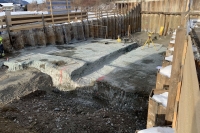Salzburg - Wörgl Railway Line, Golling Section
Client: Austrian Railways Infrastructure AG
Development Period: since 2017
In the context of the development of the railway line Salzburg - Wörgl, the section in the locality of Golling with a length of 580 m is being straightened. In addition to the enlargement of the embankments for the open track, the railway crossings Wasserfall Road and Moartal Road (Ramsl Road) will be replaced by underpasses. Due to the high ground water level, both underpasses, along with the ramps, have to be carried out as watertight troughs.
For this project, BGG Consult was entrusted with the geotechnical and hydrogeological consulting during all design and building phases.
This first included the planning, supervision and evaluation of subsoil exploration works. Based on the results, geotechnical expert's reports were prepared for the permission procedure pertaining to railway law and for the procedure pertaining to water and waterways. For the tender, expertise was provided in the field of geotechnics and hydrogeology, the geotechnical expert's report was adapted to the actual design and construction pit support systems were dimensioned.
During construction, the special heavy construction works were accompanied from a geotechnical and hydrogeological point of view and a hydrogeological preservation of evidence implemented.
Ground Water Lowering Measures:
For the construction of the stairway buildings and retaining walls, which are situated directly beside the tracks, almost vertical building pit walls with heights of up to 6 m had to be prepared in the immediate vicinity of the railway line. In some areas, the building pit walls are used at the same time for permanent retaining walls.
As the most suitable and economical support method, anchored shotcrete walls were implemented. For the two topmost anchor rows, bar anchors, stressed together from both sides of the embankment in order to minimise the deformation, were used. The lower sections of the shotcrete walls were braced with grouted self-drilling anchors.
November 2021
